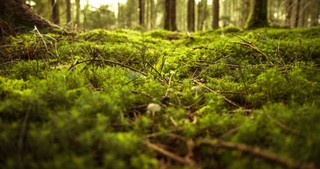Peat moss: Growing benefits, uses, and comparison to Coco Coir

If you’ve talked to anyone who is enthralled with gardening, or done a quick internet search yourself there’s a high likelihood you’re acquainted with the term peat moss. Chances are high too that you’re wondering exactly what it is, why you’d want to use it for gardening, or exactly how or when you should use it. If that’s the case, you’ve come to the right place - let’s talk peat moss!
Peat versus peat moss
The terms “peat” and “peat moss” are used interchangeably quite often, but it’s important to understand there is a slight difference in the two.
Peat is an accumulation of partially decayed vegetation that slowly forms layers in marshy, wet areas of the Northern hemisphere known as peatlands. Slow draining soils and cool temperatures create an environment low in oxygen and bacteria activity, where plant biomass production is greater than the decomposition rate.
Over time, the slow decomposition process yields itself to the formation of a homogenous, densely fibrous material that is highly absorbent. The layers created in these wet areas are what we know as peat.
Peat moss, on the other hand, is a type of peat characterized by its vegetative composition. The type of vegetation decaying to form the peat can vary a bit, depending on the region and the nutrient content of the peatland.
- Nutrient poor areas such as bogs are home for plants such as sphagnum mosses, carnivorous plants, ericaceous plants (i.e. blueberries, heathers, rhododendrons, and camellia), and cranberries.
- Areas known as fens have dissolved mineral nutrients in the water, sustaining a wider range of plants: cattails, herbaceous species, vascular plants, shrubs, and the occasional tree.
In areas where sphagnum mosses are the main source of vegetation accumulating, the resulting peat formed is often known as peat moss or sphagnum peat moss. So peat is an umbrella term describing all types of accumulated decayed vegetation; peat moss is used to describe peat formed with a high amount of sphagnum moss.
 Harvesting in a peat bog.
Harvesting in a peat bog.
How peat moss is harvested
Harvesting peat moss is a pretty labor intensive process due to the nature of peatlands. Producers try to be sustainable in their harvesting practices, carefully assessing sites to choose the most appropriate one to harvest and then leaving some of the peat to facilitate regeneration.
- First off a series of ditches are dug around the peatlands to allow the water to drain. A main drainage ditch is dug around the entire perimeter; shallower ditches are dug parallel to one another to reduce the water content in the peat to about 85%.
- Surface vegetation is removed to expose the peat. This living sphagnum moss is collected and used to either restore former peat harvesting areas or to make liners for hanging baskets.
- Harvest fields are leveled and then slightly crowned to encourage drainage of the surface runoff.
- Surface layer of peat is milled and harrowed to loosen it and accelerate the drying process.
- When the surface layer reaches about 50% moisture it is harvested using large vacuum harvesters.

The enthusiast's guide to herbs
We’re proud to present our new e-book, The Enthusiast’s Guide to Herbs! Learn everything you need to know about growing and caring for herbs indoors, including in-depth info cards for the 35 most commonly grown herbs.
Click the link below to find out more!
Benefits of peat moss
Peat was originally dried and used as a fuel source until about the 1940s when it found a foothold in horticulture. Harvested peat moss is one of the most widely used types of growing media in the industry today because of the following characteristics.
-
Excellent water holding capacity - According to Science Daily, peat mosses can hold up to 25 times their dry weight in water; more than natural sponges have the capability of doing.
-
Slightly acidic pH - Depending on the peat source, most peat mosses have a pH in the range of 3.5 to 6 on average. For certain plants, having a growing medium with a slightly acidic pH is a big advantage.
-
Lightweight - Once it is harvested and dried, peat moss weighs approximately 25 pounds per cubic foot; in comparison, a cubic foot of top soil weighs about 40 pounds.
-
Doesn’t compact - After peat is dried down to create peat moss the resulting product is very “springy” and resists compaction, allowing for plenty of open pore space within the material.
-
Drains freely - Even though peat moss retains water incredibly well it also has the ability to drain freely. Excess water quickly moves through the material to drain out.
-
Sterile - Since it formed in unaltered, low oxygen conditions peat moss doesn’t contain bacteria, fungus, weed seeds, or harmful chemicals.
-
Holds nutrients - Peat moss doesn’t naturally have much mineral content since it forms in nutrient-poor areas. Due to its structure though it has a high cation exchange capacity, or more simply, it has many negatively charged sites that can hold onto positively charged molecules such as nutrients and water.
-
Clean to work with - Unlike some other growing media, peat moss is easy and clean to work with. It doesn’t leave behind the dust and mess that compost can, and doesn’t blow around like perlite.
 A potting mix with peat moss in it is a great soil to start seeds in!
A potting mix with peat moss in it is a great soil to start seeds in!
Disadvantages of peat moss
On the flip side, there are some drawbacks to using it as well.
-
Expensive - Compared to other soil amendments, or growing media, pure peat moss comes with a higher price tag. This increased cost is due to the harvesting process.
-
Low nutrient content - Peat bogs containing sphagnum moss are nutrient-poor due to a high water table and lack of nutrients. Therefore the resulting peat moss formed is low in nutrients as well.
-
Slightly acidic pH - In some situations the slightly acidic pH of peat moss makes it advantageous; in some cases, a slightly acidic pH is a big strike against itself.
-
Non-renewable - Unlike other growing media or horticultural amendments, peat moss forms really slowly. Its use often comes under fire because of this as it is classified as some to be a nonrenewable resource.
How to use peat moss
Due to its many advantages, peat moss is used in a variety of horticultural aspects, hence its popularity in the industry.
- Potting soil - Peat moss is a staple ingredient in many soilless potting mixes used in container gardening. Potting soil is a mix of organic matter such as peat moss, coconut coir, or compost along with perlite, vermiculite, or even sand. The organic materials provide the bulk of the material and water holding capacity; the other items help with aeration, drainage, and keeping the mix lightweight. Our favorite brand of potting soil is Fox Farm, you can learn more on Amazon here.
- Soil amendment - It also works well as a soil conditioner. Dry sandy soils benefit from adding peat moss to them as it increases the water retention. Clay soils see an improvement in drainage and experience less compaction with the addition of peat moss. An alkaline soil with a high pH can be brought closer to neutral conditions by adding peat moss.
- Seed starting - With an absence of weed seeds, fungus, and diseases, peat moss is commonly used in nurseries and by homeowners to germinate seeds. Its sterile nature reduces the occurrence of damping-off but also retains plenty of moisture to keep seeds sufficiently wet until roots form.
- Hydroponics - The exploding popularity of hydroponic systems in the last couple of decades has opened up another popular use for peat moss. It works well in hydroponics because of its water-holding capacity, ability to drain well, high cation exchange capacity, its sterile nature, and resistance to compaction.
Deciding when to use peat moss
Know that you understand the basic ins and outs of peat moss, let’s talk about when you should use it and when it’s best to skip it and find a suitable alternative.
When to use peat moss
- As a component when making your own DIY potting mix.
- When growing plants and herbs that prefer an acidic soil.
- When sandy soils need better water-holding capacity.
- When clay soils need better drainage.
- When starting seeds.
 Peat moss soil.
Peat moss soil.
When to avoid using peat moss
- When growing plants and herbs that prefer alkaline soil.
- Blackberries, raspberries, huckleberries, currants, gooseberries.
- Boston ivy, honeysuckle, clematis.
- Garlic, ginger, lavender.
- Black-eyed susans, daylilies, hostas, shasta daisy.
- When mulching your garden or flowerbeds. Peat moss causes surface cracking of your garden soil when it dries out.
- When compost from your compost pile is readily available. Compost has similar benefits to peat moss and is a renewable resource.
Peat moss vs coconut coir
As mentioned in the disadvantages, one of the drawbacks to using peat moss is that it is a non-renewable resource. There are many conservationists, wetland scientists, and even gardeners who are calling for a total boycott of peat and its byproducts.
There is also an environmental concern that comes with harvesting peatlands across Canada and parts of the United States. Peatlands store a great percentage of carbon – about 10% of our earth’s fixed carbon. When they are harvested this carbon is released into the atmosphere, contributing to global warming. While producers are adamant their practices are sustainable, there has been an interest in moving towards products such as coconut coir as a replacement.
Coconut coir - also known as coco coir - is composed of the brown and white fibers found between the shell and the outer coating of a coconut seed.[1] It is similar in ways to peat moss but has many other benefits: it resists compaction and decomposition, it has a pH close to neutral conditions (5.2 - 6.8 typically), it promotes the growth of beneficial bacteria in the root zone due to the presence of lignins, it is rich in hormones and bio-stimulants to promote plant growth, and depending on the source it may contain plant essential nutrients such as potassium, iron, copper, manganese, and zinc.
Advantages such as a more neutral pH and it containing plant essential nutrients, hormones, and bio-stimulants make it attractive.
Conclusion
Peat moss has been a staple in the horticulture industry for the better part of the last century due to its water holding capacity, sterile nature, and slightly acidic pH. It is commonly used as an ingredient in potting soils, as a soil amendment, for starting seeds, and in hydroponics gardening systems. Its use does come under scrutiny for being a non-renewable resource and some consideration must be taken to determine if peat moss is the best product for your needs.

Join our email club—get printable info cards free!
Sign up to receive our newsletter and get access to 10 printable plant info cards from our e-book for free. Also receive:
- $4 discount code for our Guide to Herbs e-book
- Semi-weekly plant inspiration & bite-size tips and tricks
Sengupta, S. & Basu, G. (2016). Properties of Coconut Fiber. In Reference Module in Materials Science and Materials Engineering. doi: 10.1016/B978-0-12-803581-8.04122-9 ↩︎
